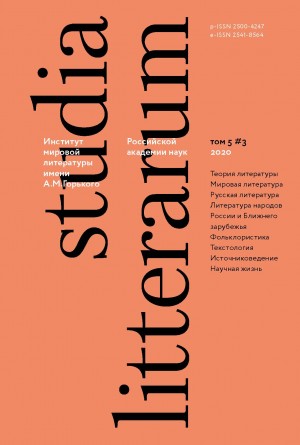The Image of Nestor Makhno in the Pages of Alexey N. Tostoy’s Trilogy The Road to Calvary: Documents and Materials
Journal title: Studia Litterarum
Authors: Galina N. Vorontsova
Subject(s): Literature, Languages and Literature

Journal title: Studia Litterarum
Authors: Galina N. Vorontsova
Subject(s): Literature, Languages and Literature
Journal title: Studia Litterarum
Authors: Elizaveta E. Baldanmaksarova
Subject(s): Literature, Languages and Literature
Journal title: Studia Litterarum
Authors: L.V. Makhova
Subject(s): Literature, Languages and Literature
Journal title: Studia Litterarum
Authors: Alexander V. Pigin
Subject(s): Literature, Languages and Literature
Journal title: Studia Litterarum
Authors: E.A. Dorokhova, O.A. Pashina
Subject(s): Literature, Languages and Literature
Journal title: Studia Litterarum
Authors: Еlena S. Kotlyar
Subject(s): Literature, Languages and Literature
Journal title: Studia Litterarum
Authors: Olga V. Bystrova
Subject(s): Literature, Languages and Literature
Journal title: Studia Litterarum
Authors: Zoya S. Zakruzhnaya
Subject(s): Literature, Languages and Literature
Journal title: Studia Litterarum
Authors: Sergey N. Zenkin
Subject(s): Literature, Languages and Literature
Journal title: Studia Litterarum
Authors: L.V. Goriaeva
Subject(s): Literature, Languages and Literature
Journal title: Studia Litterarum
Authors: L.V. Evdokimova
Subject(s): Literature, Languages and Literature
Journal title: Studia Litterarum
Authors: T.V. Govenko
Subject(s): Literature, Languages and Literature
Journal title: Studia Litterarum
Authors: E.V. Astashchenko
Subject(s): Literature, Languages and Literature
Journal title: Studia Litterarum
Authors: V.M. Kirillin
Subject(s): Literature, Languages and Literature
Journal title: Studia Litterarum
Authors: G. Rimondi
Subject(s): Literature, Languages and Literature